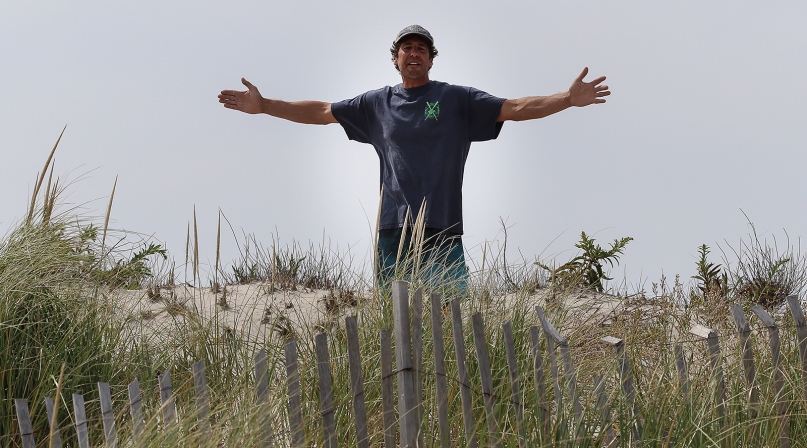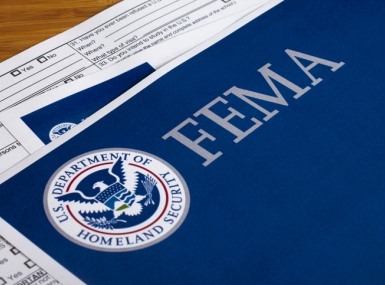Hurricane Sandy showed nature can play a role in reducing flood risk
Author

Linda Langston

Mr. Nate Woiwode
Upcoming Events
Related News

Communities can use nature-based solutions to help mitigate flood risk, produce other benefits
In mid-September, as tens of thousands of people were still reeling from Hurricane Harvey and while Hurricane Irma was wreaking havoc in the Southeast, representatives of The Nature Conservancy, American Planning Association, and NACo visited South Seaside Park, N.J., which serves as a case study for NACo’s Naturally Resilient Communities partnership. It was a trip we’d planned weeks before Harvey was even on the radar.
Standing on the wide beach there, looking back at the dunes, the roofs of the cottages on the other side were barely visible. It wasn’t difficult to imagine how these dunes, that stretch 20 blocks, protected the homes behind them from the storm surge Hurricane Sandy brought with it five years ago.
Dominick Solazzo, who has advocated for the dunes and helped build and protect them for over 10 years, served as our guide. He clambered up a dune, and when he stood a couple of feet below the crest, turned around and said, “The surge made it up to this point. Immediately north and south of here, the storm surge flowed onto streets and into homes. But our dunes held and protected the homes behind them.”
The dunes at South Seaside Park aren’t there, in their current form, by accident. In fact, the town had at one time removed them to improve beach access and views. But a Nor’easter in 1992 caused significant flooding and caused the community to rethink their decision. It was then that the community began efforts in earnest to rebuild the dunes, with measures as simple as snow fencing to catch the sand and native grasses to hold it in place. By the time Sandy struck in 2012, the dunes were 25 feet high and some 150 feet wide—large enough to withstand Sandy’s storm surge that inundated coastal communities throughout much of New Jersey and New York.
Sand dunes, however, weren’t the only type of nature-based solution that proved effective during Sandy. The Nature Conservancy recently worked with the insurance industry to use insurance risk models to show that coastal wetlands in the northeastern U.S. prevented $625 million in property damages from flooding during Hurricane Sandy. The Conservancy’s South Cape May Meadow Preserve, located 90 miles south of South Seaside Park, illustrates the value of wetlands and their ability to mitigate flooding during storms. In addition to helping protect neighboring homes from flooding during Sandy, the preserve also attracts an estimated 250,000 visitors a year, many of them birders who also stay in nearby hotels and patronize local restaurants and shops.
It is examples like these the Naturally Resilient Communities partnership seeks to promote—examples that show how communities can use nature-based solutions, or “natural infrastructure,” to help mitigate flood risk while producing other benefits, like improved water quality or enhanced recreational opportunities or wildlife habitat, all of which can boost local economies. This is particularly important, because flooding is the costliest type of disaster in the United States. Average flood losses have increased steadily to nearly $10 billion annually, which has driven the National Flood Insurance Program at least $25 billion into debt. And these figures will undoubtedly increase because of flooding caused by Harvey and Irma.
In light of the loss of lives and destruction recent hurricanes have caused, we feel it important to note that while more dunes or marshes might have helped reduce storm surges associated with the recent hurricanes, and more wetlands would have helped absorb some of the rainfall, there’s no way any amount of nature-based solutions—or any amount of “built infrastructure”—could have prevented all the destruction. These were truly natural disasters.
Reducing the risks that storms pose will always involve multiple solutions working together. Whether establishing early warning systems, investing in manmade solutions like reservoirs, dams, levees, seawalls and pumps, working with willing communities and homeowners to relocate people from areas that are subject to frequent flooding, or identifying the potential for nature-based solutions, communities should consider the suite of options available to them.
In spite of this harsh reality, our message remains—nature should be part of the solution for building resilient communities. As people recover from major storms, they have the opportunity to shape the future of their communities. Making strategic investments in nature-based solutions is an important part of a creating safer, healthier, more prosperous and more resilient communities now and in the future.
Attachments
Related News

Cross-training helps county 911 scale up for big emergencies
With training, Howard County, Md. staff help filter and respond to non-emergency requests for information and assistance during period of heavy 911 call volume.

States file lawsuit challenging FEMA’s new rules on emergency management grants
On November 4, a coalition of 12 states filed a lawsuit against the U.S. Department of Homeland Security (DHS) and the Federal Emergency Management Agency (FEMA), alleging that recent changes to key emergency management grants are unlawful and could disrupt state and local preparedness efforts.

County Countdown – Nov. 4, 2025
Every other week, NACo's County Countdown reviews top federal policy advocacy items with an eye towards counties and the intergovernmental partnership.